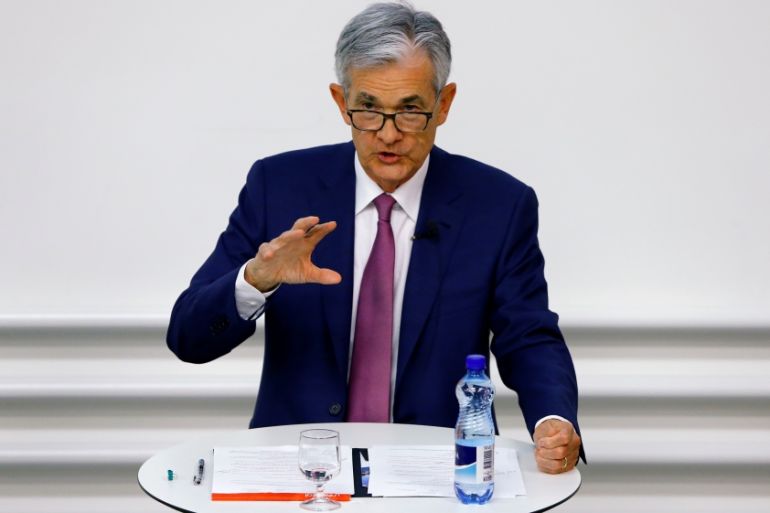Trump demands negative interest rates from Fed ‘boneheads’
US president jawbones politically independent central bank on Twitter to push rates even below zero, in apparent shift.

United States President Donald Trump has called on the “boneheads” at the Federal Reserve to push interest rates down into negative territory. Such a move has been reluctantly used by central banks elsewhere to battle weak economic growth, but it risks punishing savers and banks’ earnings in the process.
In a pair of Twitter posts on Wednesday, Trump said negative rates would save the government money on its debt – which, including Social Security accounts, has reached a record $22 trillion on Trump’s watch.
Keep reading
list of 4 itemsBoeing hit with 32 whistleblower claims, as dead worker’s case reviewed
US imposes new sanctions on Iran after attack on Israel
A flash flood and a quiet sale highlight India’s Sikkim’s hydro problems
He did not address the risks or financial market tensions that central banks in Europe and Japan have confronted as a result of their negative-rate policy. Trump also seems to have ignored the larger issue: negative rates have not secured higher growth or higher inflation for those economies.
“The Federal Reserve should get our interest rates down to ZERO, or less, and we should then start to refinance our debt. INTEREST COST COULD BE BROUGHT WAY DOWN, while at the same time substantially lengthening the term,” Trump tweeted.
“We have the great currency, power, and balance sheet … The USA should always be paying the … lowest rate. No Inflation!”
“It is only the naivete of [Fed Chairman] Jay Powell and the Federal Reserve that doesn’t allow us to do what other countries are already doing,” added Trump, who has repeatedly noted that rates are negative in Germany, Europe’s trading powerhouse.
The president’s comments precede a week in which the world’s major central banks, including the Fed, are expected to lower rates or otherwise loosen monetary policy in what is widely seen as a coordinated move to protect the global economy against risks partly rising from Trump’s trade war with China.
‘Money is even cheaper’
But the quarter of a percentage point cut expected by the Fed next Wednesday is not likely to satisfy Trump, who has called on Powell and the Fed to cut rates quickly and dramatically as a way to boost slowing US economic growth ahead of his re-election bid next year.
Last month, however, Trump told reporters at the White House that he did not want to see negative rates in the US, and analysts on Wednesday said the still-growing US economy would be put at risk if the Fed pursued them.
While perhaps appropriate in recessionary conditions, rates at or below zero in a growing economy with record-low unemployment “may ultimately create the next financial crisis”, said Mark Luschini, chief investment strategist at Janney Montgomery Scott in Philadelphia.
“People [would be] taking on more risk than they would otherwise because money is even cheaper,” Luschini said.
Trump has often bragged about his use of debt as a real estate investor. As far as managing the federal government’s affairs, interest on outstanding US Treasury securities will be nearly $400bn in the current fiscal year and rise to more than $914bn by 2028, according to the Pew Research Center.
Still, interest accounts for about 8.7 percent of all federal outlays, down sharply from the mid-1990s, when it accounted for more than 15 percent of spending following an era of ultra-high interest rates in the 1970s and 1980s, the Pew data showed.
The Washington Post, citing public filings and financial experts, reported last month that Trump could also personally save millions of dollars a year in interest if the Fed lowers rates, given the outstanding loans on his hotels and resorts.
‘Every tool available’
A White House official speaking on background said in response to Trump’s tweets that “the president is looking at every tool available to lower the national debt, and we ask Congress to join us in cutting back on wasteful spending”.
Meanwhile, even though Trump hand-picked Powell as head of the US central bank, he quickly soured on his by-the-book approach and insistence on the Fed’s political independence.
The president last month referred to Powell as an “enemy” on par with the head of the Communist-led Chinese government and kept up his personal line of attack in his tweets on Wednesday: “A once in a lifetime opportunity that we are missing because of ‘Boneheads’.”
The Fed cut interest rates in July for the first time in more than a decade. Financial markets expect the Fed to again lower its benchmark rate, currently at two to 2.25 percent, when it meets September 17-18.
Regardless of Trump’s name-calling, US Treasury Secretary Steven Mnuchin told reporters at the White House on Monday that he expected Powell’s job was safe, despite months of speculation that the president could seek to oust him.
Fed officials have suggested the idea of setting their target policy rate below zero as not worth the risks. The policy is meant to account for extremely weak economic conditions by essentially charging banks to hold reserve deposits at the Fed.